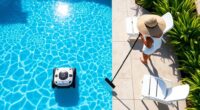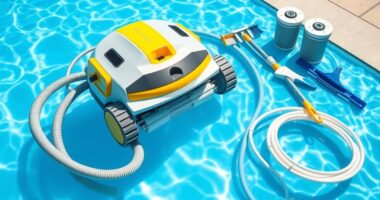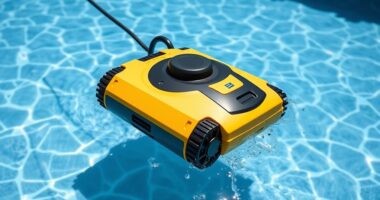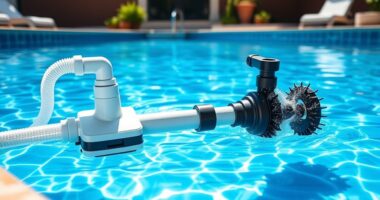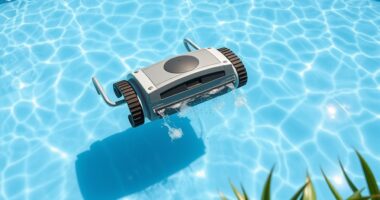To create the ultimate pool cleaning schedule, balance automatic cleaners with manual tasks like skimming, brushing, and inspecting filters. Run your automatic cleaner daily and test chemical levels twice a week to keep water safe and clear. Regularly brush walls and spot-clean debris to prevent buildup. Proper filter maintenance guarantees your system runs smoothly. Stick to this routine, and you’ll stay ahead of common issues—continue exploring for expert tips on perfecting your pool care routine.
Key Takeaways
- Schedule automatic cleaners daily to maintain consistent debris removal and reduce manual effort.
- Test and adjust water chemistry twice weekly to prevent imbalances that hinder cleaning efficiency.
- Skim surface debris every few days to complement automatic cleaning and prevent buildup.
- Brush walls and floors weekly to remove algae and dirt missed by automatic devices.
- Regularly inspect and clean filters biweekly to ensure optimal operation of both automatic and manual cleaning methods.
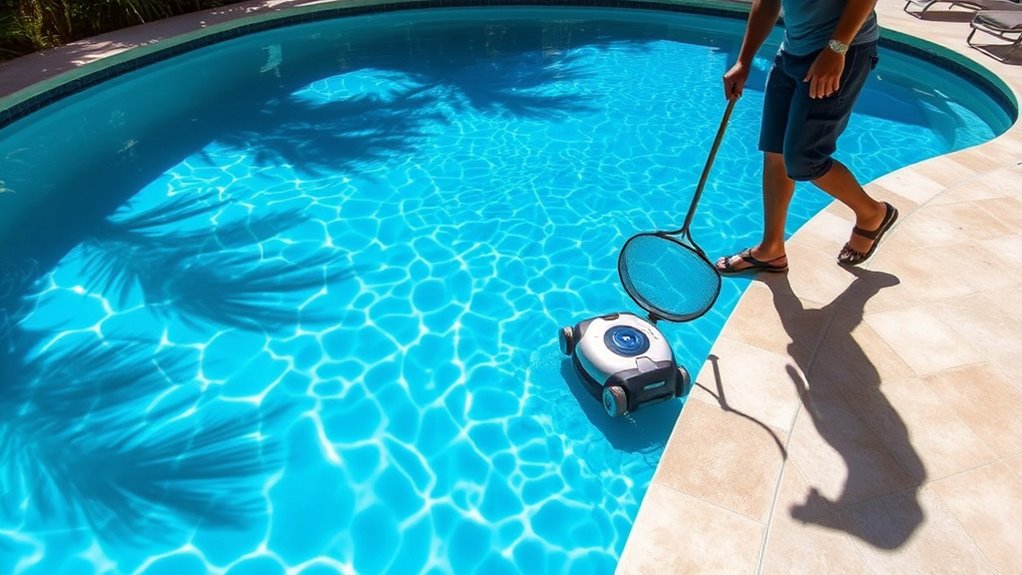
Maintaining a clean pool requires a consistent cleaning schedule to guarantee safe and enjoyable swimming. One of the most important aspects of this is ensuring the pool chemical balance stays in check. Properly balanced chemicals prevent algae growth, cloudy water, and corrosion of pool equipment. Regular testing of pH, chlorine levels, alkalinity, and stabilizer helps you catch imbalances early. Typically, you should check these levels at least twice a week during peak swimming season, but during off-season or cooler months, weekly testing may suffice. Seasonal maintenance is also vital—before opening your pool in the spring and after closing in the fall, you should perform thorough chemical adjustments and cleanings. This prevents issues like mineral buildup or algae colonization that can develop during months of inactivity.
Consistently testing and balancing pool chemicals ensures safe, clear, and healthy swimming conditions year-round.
In addition to chemical management, a well-rounded cleaning schedule combines automatic and manual methods for ideal results. Automatic pool cleaners, such as robotic or suction-side vacuums, are excellent for routine debris removal. They operate on a timer, continuously or periodically cleaning the bottom and sides of your pool, saving you time and effort. However, automatic cleaners aren’t enough on their own. You still need to manually skim the surface for leaves, insects, or floating debris that may not be caught by the cleaner. Brushing the pool walls, steps, and floor once a week helps prevent algae and dirt buildup that automatic cleaners might miss, especially in hard-to-reach corners. Additionally, understanding the benefits of glycolic acid in pool maintenance can help improve overall water quality and skin comfort for swimmers. Incorporating proper chemical balance practices also supports the efficiency of your automatic cleaning devices. Regularly inspecting and maintaining your pool’s filtration system ensures optimal water circulation and clarity. Implementing automatic cleaning devices alongside manual efforts can significantly reduce your overall maintenance time.
Skimming and brushing should be complemented by regular filter maintenance. Your filter traps dirt, pollen, and other particles, but it needs to be cleaned frequently—usually once every couple of weeks during heavy use. Keeping your filter in top condition ensures the automatic cleaner works efficiently and your water remains clear. Also, backwashing or rinsing the filter prevents clogs that could compromise chemical circulation and water quality.
To streamline your pool cleaning schedule, establish specific days for different tasks. For example, test and adjust chemicals twice a week, run the automatic cleaner daily, skim debris every couple of days, and brush the walls once a week. During seasonal maintenance, dedicate extra time to deep cleaning, inspecting equipment, and performing thorough chemical adjustments. Sticking to this routine minimizes surprises and keeps your pool safe, clear, and inviting for every swim. By balancing automatic and manual cleaning tasks along with vigilant chemical management, you’ll enjoy hassle-free pool ownership all season long.
Frequently Asked Questions
How Often Should I Replace My Pool Filters?
You should replace your pool filters based on their filter lifespan and replacement frequency recommendations. Typically, cartridges last about 1-2 years, while sand and DE filters can last 5-7 years with proper maintenance. Keep an eye on your filters for signs of wear or decreased efficiency, and replace them when they no longer clean effectively. Regularly checking your filters ensures ideal water quality and prolongs their lifespan.
Can Manual Cleaning Damage My Pool Surface?
Ever wondered if manual cleaning could harm your pool surface? It’s a valid concern, especially if you use harsh manual cleaning techniques or scrub too aggressively. While manual cleaning is essential for thorough pool surface maintenance, improper methods can cause scratches or damage. To avoid this, use gentle brushes, soft cloths, and proper tools. Stay cautious, and you’ll keep your pool surface sparkling without risking damage.
What Are the Signs My Automatic Cleaner Isn’T Working Properly?
If your automatic cleaner isn’t working properly, you might notice pool algae buildup, uneven cleaning, or strange noises. Check for clogged brushes, worn-out parts, or low pressure, which indicate a need for automatic cleaner maintenance. Regularly inspecting and maintaining your cleaner guarantees it operates efficiently, preventing algae growth and keeping your pool pristine. Address issues early to avoid costly repairs and enjoy a clean, algae-free swimming experience.
How Do I Balance Chemicals During Heavy Pool Usage?
Heavy pool usage can turn your pristine water into a chemical chaos. You need to stay proactive by regularly testing your water with accurate chemical testing. If pH levels get out of balance, adjust them promptly to prevent algae growth or cloudiness. Keep a close eye on chlorine levels, and add chemicals as needed. Consistent monitoring and quick pH adjustment help maintain crystal-clear water, even during busy swimming days.
Is It Necessary to Close the Pool in Winter?
You might wonder if winter closure is necessary for your pool. If you live in a cold climate, closing your pool for seasonal maintenance prevents damage from freezing temperatures and reduces long-term upkeep. In milder regions, you can keep it open with proper winterization. Ultimately, winter closure depends on your local climate and pool usage, but preparing it for winter guarantees it stays in good shape for the next season.
Conclusion
By balancing automatic and manual cleaning, you’re like a skilled gardener tending to your pool’s health. Imagine your pool as a vibrant garden—automatic cleaners are the steady watering cans, keeping things consistent, while manual cleaning is like pruning and weeding, catching what the automatic misses. Together, they create a sparkling oasis that feels inviting and well-cared-for. With this schedule, your pool will stay pristine, inviting you to leap in anytime, just like stepping into a lush, thriving garden.

